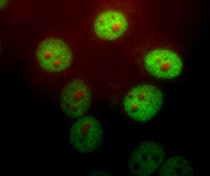ARG10687
anti-Pin 1 antibody
anti-Pin 1 antibody for ICC/IF,IHC-Frozen sections,Western blot and Human,Mouse,Rat,Cow,Horse,Pig
Overview
| Product Description | Chicken Polyclonal antibody recognizes Pin 1 |
|---|---|
| Tested Reactivity | Hu, Ms, Rat, Cow, Hrs, Pig |
| Predict Reactivity | Chk |
| Tested Application | ICC/IF, IHC-Fr, WB |
| Host | Chicken |
| Clonality | Polyclonal |
| Isotype | IgY |
| Target Name | Pin 1 |
| Immunogen | Recombinant full length Pin-1 purified from E. coli. |
| Conjugation | Un-conjugated |
| Alternate Names | UBL5; PPIase Pin1; DOD; Peptidyl-prolyl cis-trans isomerase NIMA-interacting 1; EC 5.2.1.8; Rotamase Pin1; Peptidyl-prolyl cis-trans isomerase Pin1 |
Application Instructions
| Application Suggestion |
|
||||||||
|---|---|---|---|---|---|---|---|---|---|
| Application Note | * The dilutions indicate recommended starting dilutions and the optimal dilutions or concentrations should be determined by the scientist. |
Properties
| Form | Liquid |
|---|---|
| Buffer | PBS and 0.02% Sodium azide. |
| Preservative | 0.02% Sodium azide |
| Storage Instruction | For continuous use, store undiluted antibody at 2-8°C for up to a week. For long-term storage, aliquot and store at -20°C or below. Storage in frost free freezers is not recommended. Avoid repeated freeze/thaw cycles. Suggest spin the vial prior to opening. The antibody solution should be gently mixed before use. |
| Note | For laboratory research only, not for drug, diagnostic or other use. |
Bioinformation
| Database Links |
Swiss-port # Q13526 Human Peptidyl-prolyl cis-trans isomerase NIMA-interacting 1 Swiss-port # Q9QUR7 Mouse Peptidyl-prolyl cis-trans isomerase NIMA-interacting 1 |
|---|---|
| Gene Symbol | PIN1 |
| Gene Full Name | peptidylprolyl cis/trans isomerase, NIMA-interacting 1 |
| Background | Peptidyl-prolyl cis/trans isomerases (PPIases) catalyze the cis/trans isomerization of peptidyl-prolyl peptide bonds. This gene encodes one of the PPIases, which specifically binds to phosphorylated ser/thr-pro motifs to catalytically regulate the post-phosphorylation conformation of its substrates. The conformational regulation catalyzed by this PPIase has a profound impact on key proteins involved in the regulation of cell growth, genotoxic and other stress responses, the immune response, induction and maintenance of pluripotency, germ cell development, neuronal differentiation, and survival. This enzyme also plays a key role in the pathogenesis of Alzheimer's disease and many cancers. Multiple alternatively spliced transcript variants have been found for this gene.[provided by RefSeq, Jun 2011] |
| Function | Peptidyl-prolyl cis/trans isomerase (PPIase) that binds to and isomerizes specific phosphorylated Ser/Thr-Pro (pSer/Thr-Pro) motifs in a subset of proteins, resulting in conformational changes in the proteins. Displays a preference for an acidic residue N-terminal to the isomerized proline bond. Regulates mitosis presumably by interacting with NIMA and attenuating its mitosis-promoting activity. Down-regulates kinase activity of BTK. Can transactivate multiple oncogenes and induce centrosome amplification, chromosome instability and cell transformation. Required for the efficient dephosphorylation and recycling of RAF1 after mitogen activation. Binds and targets PML and BCL6 for degradation in a phosphorylation-dependent manner. Acts as a regulator of JNK cascade by binding to phosphorylated FBXW7, disrupting FBXW7 dimerization and promoting FBXW7 autoubiquitination and degradation: degradation of FBXW7 leads to subsequent stabilization of JUN. [UniProt] |
| Calculated MW | 18 kDa |
| PTM | Phosphorylation at Ser-71 by DAPK1 results in inhibition of its catalytic activity, nuclear localization, and its ability to induce centrosome amplification, chromosome instability and cell transformation. |
Images (2) Click the Picture to Zoom In
-
ARG10687 anti-Pin 1 antibody ICC/IF image
Immunocytochemistry: HeLa cells stained with ARG10687 anti-Pin 1 antibody at 1:1000 dilution (green) and co-stained with a monoclonal 38F3 to fibrillarin (red). Pin-1 stains the nuclear matrix and, much more faintly, the cytoplasm. The fibrillarin antibody marks nucleoli.
-
ARG10687 anti-Pin 1 antibody WB image
Western blot: Whole HeLa cell homogenate stained with ARG10687 anti-Pin 1 antibody at 1:10000 dilution. A prominent band running with an apparent SDS-PAGE molecular weight of ~21 kDa corresponds to Pin1.







